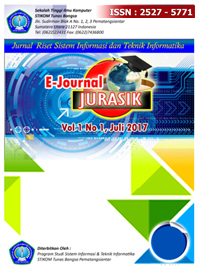Moodle Sebagai Pembelajaran Dalam Sekolah Menengah Atas
Abstract
Full Text:
PDFReferences
O. Dodun et al., “Analysis of an E-learning Platform use by Means of the Axiomatic Design,” Procedia CIRP, vol. 34, pp. 244–249, 2015.
I. K. Suartama, “Kualitas Pembelajaran Pada Mata Kuliah Media,” J. Pendidik. dan Pengajaran, vol. 43, no. 3, pp. 253–262, 2010.
V. Balasubramanian and S. Margret Anouncia, “Learning style detection based on cognitive skills to support adaptive learning environment – A reinforcement approach,” Ain Shams Eng. J., 2016.
P. Purnawarman, S. Susilawati, and W. Sundayana, “The use of Edmodo in teaching writing in a blended learning setting,” Indones. J. Appl. Linguist., vol. 5, no. 2, p. 242, 2016.
D. Zhang, L. Zhou, R. O. Briggs, and J. F. Nunamaker, “Instructional video in e-learning: Assessing the impact of interactive video on learning effectiveness,” Inf. Manag., vol. 43, no. 1, pp. 15–27, 2006.
A. Bajahzer, A. Al-ajlan, and H. Zedan, “Exercise Services for E-Learning in Higher Education With Open Source Software,” IADIS Int. Conf., no. Berry 2005, pp. 51–59, 2008.
F. Destiawati, H. Dhika, and J. Purnama, “Perbandingan Cloud Computing Microsoft Onedrive , Dropbox , dan Google drive,” vol. 12, no. 58, pp. 20–27, 2019.
DOI: http://dx.doi.org/10.30645/senaris.v1i0.29
Refbacks
- There are currently no refbacks.
 








